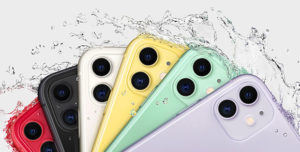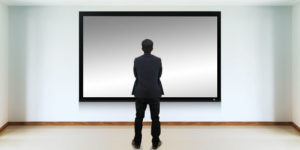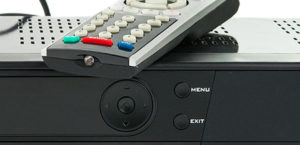
You know how frustrating it is to have a wireless call dropped, right? Or to have such a weak connection that you can’t make a call at all. Very frustrating, to say the least. Now imagine that problem happening on a regular basis. Sounds like problems we had 10 years ago, right? Well, that is still everyday life in too many cities and towns around the United States. I call them black holes in wireless coverage, and I’ll explain why.
Then, as my Pick of the Week topic, I’ll tell you how the rich use technology — about startling new numbers on things like smartphones and big-screen TVs.
Wireless Service Black Holes
Remember the Verizon Wireless television commercials that screamed, “Can you hear me now?” It may be hard to believe, but today many cities still have this problem, and consumers are still complaining at the top of their lungs: No, we cannot hear you now. Fix it already.
The problem is not just with Verizon Wireless either. It is also with AT&T Mobility, Sprint Nextel, T-Mobile, MetroPCS, Tracfone and countless other networks.
Don’t get me wrong. I love cellular. Wireless is one of the best things that ever happened. But as I travel around the country I have experienced quite a few of these black holes in coverage.
On occasion, I read a good article trying to bring this problem to the attention of anyone who can do something about it.
The September issue of Hilton Head Monthly Magazine had one, written by Sally Mahan.
Depending on where you are standing, you either have a strong signal or no signal. If you are driving, you often lose a call right in the middle.
Lori Goodridge-Cribb, the publisher of the magazine, experiences the same problems. So do I. And so does everyone else on the island — and that’s the point. Maybe we all need to put our voices together and demand better coverage.
There are countless dead spots all over the U.S. — embarrassing to the carriers, damaging to their brand, and frustrating to their customers. This is 2011. It’s about time to get good coverage already, don’t you think?
Not Good Enough
So what is the problem, exactly? Wireless carriers either don’t realize or choose to ignore this problem. Don’t they realize letting it continue is hurting them? Many customers from outside these areas visit and experience the service problems. That will enter into their decision-making process when deciding whether to renew their service.
Carriers spend a fortune on advertising, marketing and brand building, but in countless areas around the United States they shoot themselves in the foot with these dead spots.
Many carriers and handset makers send me their phones to use and compare. While, generally speaking, they all have good coverage, they all still have serious black holes.
There is a map of Hilton Head Island accompanying Mahan’s article, which highlights these dead spots. There are several, and they are large. There is no excuse for this. This is the way the entire industry was a decade ago — like swiss cheese. Since then, the carriers have invested billions and improved service. Good. But not yet good enough.
Be Responsive or Be Regulated
Today it looks like carriers are upgrading their larger markets for all the whiz-bang 4G technology, and not filling in the dead spots in other areas to give people basic connectivity.
I guess it depends which lens you look through — the investor’s or the customer’s — to decide whether this is smart or not.
Let me give you a bandage till the problem is solved. Consider a Femtocell. Strange name for a simple solution. If you have no cellular connection in your home or office, and if you use a high speed Internet line, get one of the Femtocells from your wireless carrier.
These devices plug into your high speed Internet line at home or in your office and give you a connection to your wireless network through the Internet. It creates a little cell around the device only accessible by passcode and powered by your Internet connection. It’s not an open cell site, but it will give you coverage if your home or office has a weak connection. This is only good for tiny spots, though.
As wireless moves from being a novelty to becoming a necessity, it is vital for carriers to take this problem seriously. Otherwise, they will have to become regulated by the government to improve service — and that is the last thing they want.
So now is your chance to get it right already, guys.
I talk with executives of all the wireless carriers and can say they really want to have the best quality service in every area. That’s when they wear their customer hat. However, when they wear their investor hat, service takes a back seat to profits.
Wireless has become a necessity. This is not a joke. It’s a matter of safety and connectivity for the customer, and a matter of building, not destroying, the brand reputations of companies.
So, come on carriers. Step up to the plate. You need this as much as we do. Stop just looking at the investor. Start looking to satisfy the customer. That, in turn, will make your investors happy.
Give us coverage! Hello… can you hear me now? Hello… hello… .

My Pick of the Week topic is how the rich use technology. There are some startling new numbers out on things like smartphones and big-screen TVs.
Fewer than half of the richest Americans use these new devices. What?
Ipsos Mendelsohn surveyed Americans with incomes over US$100,000 and found that new tech like tablet computers, smartphones and flat-screen televisions are owned by fewer than you’d think.
Nine percent own tablet computers. That’s up from 2 percent a year ago. Remember, this entire sector is only a year-and-a-half old, though.
E-readers win over tablet computers. Even though tablet computers get the big-dollar advertising budget, e-readers are still outselling them.
E-readers are owned by 13 percent compared to the 9 percent who own tablets.
Forty-five percent own smartphones.
Four percent use MySpace once in a while.
Fifty-nine percent use Facebook — greater than the 52 percent of the general U.S. population who use it.
Eight percent of the higher-income respondents use Twitter — less than the 11 percent of the general U.S. population who use it.
In this world, the future looks brighter than ever for these new companies.
Of course, after looking at all this, I would like to remind you that traditional television, print and radio are still not only very relevant for the affluent community, but vital.
Remember when we thought the boring newspapers, magazines, television and radio were supposed to fade away? Well they are still hot.
In fact, the world of advertising and marketing and public relations has simply expanded.













































Of the examples of companies you’ve mentioned one sorta stands out as the odd one – Tracfone. They don’t have their own network, and rely very much on the carrier they’re buying ‘airspace’ from. More pertinently; buying a normal tracfone is usually cheap enough (if not free), to get two cellphones, both running on different technologies. If anything, not to eliminate ‘black holes’, but to gage which carrier’s service is best, without having to commit to a contract, or a major capital outlay.